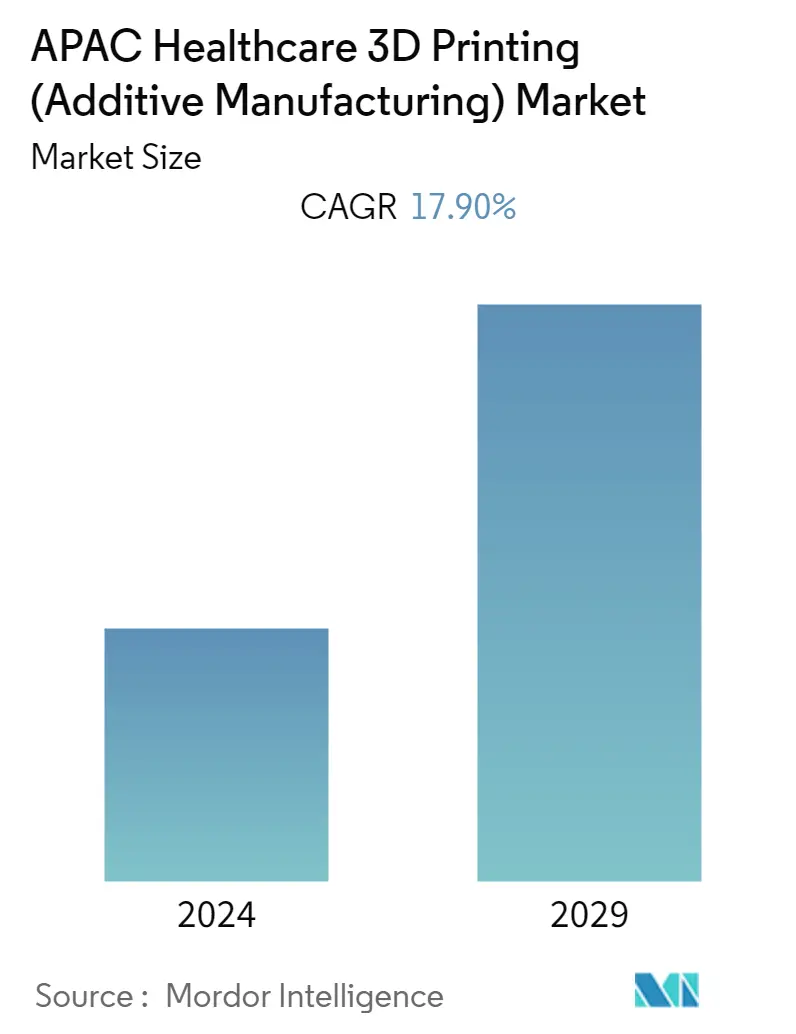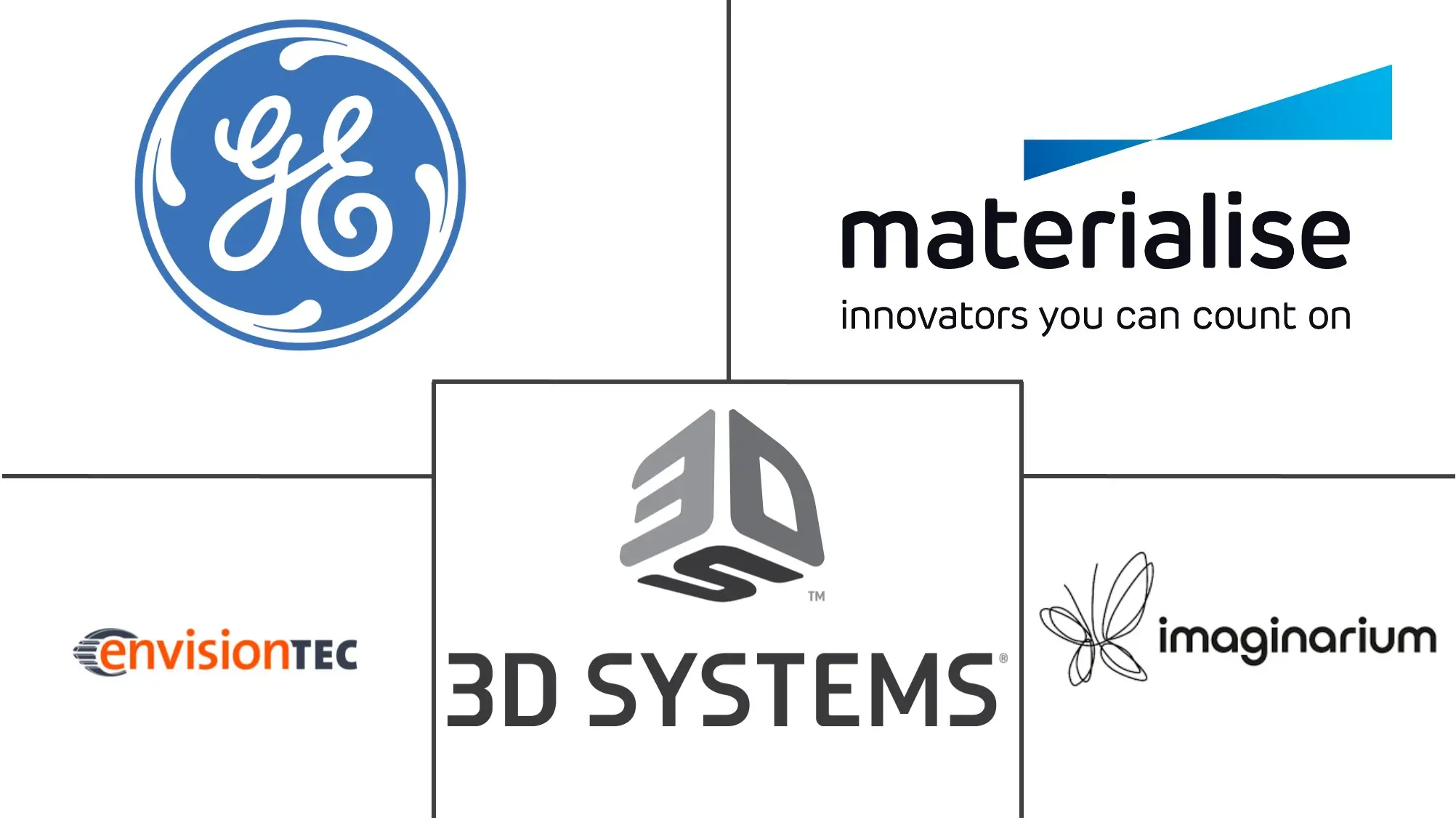Market Size of APAC Healthcare 3D Printing (Additive Manufacturing) Industry

| Study Period | 2019 - 2029 |
| Base Year For Estimation | 2023 |
| Forecast Data Period | 2024 - 2029 |
| Historical Data Period | 2019 - 2022 |
| CAGR | 17.90 % |
| Market Concentration | Medium |
Major Players
*Disclaimer: Major Players sorted in no particular order |
Asia-Pacific Healthcare 3D Printing Market Analysis
The Asia-Pacific Healthcare 3D Printing (Additive Manufacturing) Market is valued at USD 0.56 billion and is expected to reach USD 1.29 billion by the year 2028, registering a CAGR of 17.9% over the forecast period.
The COVID-19 pandemic had a significant impact on the market studied. According to the National Institute of Health study published in 2020, 3D printing was used extensively during the pandemic and was being utilized to produce vital medical supplies during the crisis. Some vital goods, including ventilator valves, face shields, swabs, oxygen valves, hand sanitizer holders, 3-D lung models, etc., were manufactured via 3D printing during the pandemic. The capacity of 3D printing to print locally using digital designs and reduce supply chain factors has been the key reason for its success. Furthermore, PubMed data published in November 2021 stated that the ability of 3D printing to manufacture/print complicated geometrical patterns locally was the primary reason for its widespread adoption during COVID-19. Therefore, it was observed that the pandemic positively impacted the market studied. However, the market has reached its pre-pandemic nature regarding demand for 3D printing and is expected to witness strong growth in the coming years.
Key factors responsible for the market growth include increasing demand for customized 3D printed parts and instruments and patent expiration. There has been an increase in the demand for customized additive manufacturing as customized structures are more comfortable for patients. For instance, in November 2021, the Australian Government expanded a world-class 3D medical manufacturing facility in Port Melbourne. Minister for Innovation, Medical Research, and the Digital Economy stated that the new investment will enable Melbourne-based 3DMEDiTech to transform its existing facility, supercharging Victoria's advanced medical manufacturing sector and reducing wait times for Victorians needing implants. Hence, with such demand for 3D printing, the market studied is expected to grow strongly in the coming years.
Additionally, data from the Journal of Controlled Release published in February 2021 stated that precision medicine has rapidly overtaken conventional medicine over the past few years. 3D printing, particularly Fused Deposition Modeling (FDM), has been proven to be a potential method for customizing oral medicine administration. The data further stated that additive manufacturing, often known as 3D printing technology, is expected to change how drugs are produced in the coming years. Hence, with the increasing use of 3D printing technology, the market studied is expected to grow significantly over the forecast period.
When patents on 3D printing technologies or specific medical devices expire, other companies can enter the market and manufacture similar products. This increased competition often leads to lower prices for 3D printers, materials, and medical devices, making them more accessible to healthcare providers and driving cost reduction in the industry.
However, additive manufacturing costs are still high, leading to affordability issues, especially in developing and underdeveloped countries. Also, there is a lack of skilled professionals to operate these machinery. These factors have impeded market growth.
Asia-Pacific Healthcare 3D Printing Industry Segmentation
Additive manufacturing is a transformative approach to industrial production that enables the creation of lighter, stronger parts and systems. This approach creates implants, instrument parts, and dummy body parts and organs in healthcare. The Asia-Pacific Healthcare 3D Printing (Additive Manufacturing) Market is segmented by Technology (Stereo Lithography, Deposition Modeling, Electron Beam Melting, Laser Sintering, Jetting Technology, Laminated Object Manufacturing, Other Technologies), Application (Medical Implants, Prosthetics, Wearable Devices, Other Applications), Material (Metals and Alloys, Polymers, Biological Cells, Other Materials), and Geography (China, Japan, India, Australia, South Korea, Rest of Asia-Pacific). The report offers the value in USD for the above segments.
| By Technology | |
| Stereolithography | |
| Deposition Modeling | |
| Electron Beam Melting | |
| Laser Sintering | |
| Jetting Technology | |
| Laminated Object Manufacturing | |
| Other Technologies |
| By Application | |
| Medical Implants | |
| Prosthetics | |
| Wearable Devices | |
| Other Applications |
| By Material | |
| Metals and Alloys | |
| Polymers | |
| Other Materials |
| Geography | |
| China | |
| Japan | |
| India | |
| Australia | |
| South Korea | |
| Rest of Asia-Pacific |
APAC Healthcare 3D Printing (Additive Manufacturing) Market Size Summary
The Asia-Pacific Healthcare 3D Printing Market is experiencing significant growth, driven by the increasing demand for customized medical solutions and the expiration of key patents. The market's expansion is further fueled by the adoption of 3D printing technologies during the COVID-19 pandemic, which highlighted the ability to produce essential medical supplies locally, thereby reducing supply chain dependencies. This period of heightened demand has led to a resurgence in market activity, with a focus on personalized healthcare solutions such as customized implants and precision medicine. The region's developing economies present lucrative opportunities for global players, as the demand for advanced medical devices and solutions continues to rise.
Technological advancements and innovative product launches are propelling the market forward, particularly in countries like Japan, where 3D printing is being integrated into regenerative medicine and wearable sensor technologies. The introduction of wearable health monitoring devices and smart sensors is enhancing patient care and monitoring capabilities. Events like TCT Japan are fostering industry knowledge and adoption of 3D printing technologies. Despite challenges such as high costs and a shortage of skilled professionals, the market is poised for robust growth, supported by both regional and global players investing in the development and commercialization of 3D printed medical devices and solutions.
APAC Healthcare 3D Printing (Additive Manufacturing) Market Size - Table of Contents
-
1. MARKET DYNAMICS
-
1.1 Market Overview
-
1.2 Market Drivers
-
1.2.1 Demand For Customized 3D Printed Parts and Instruments
-
1.2.2 Patent Expiration
-
-
1.3 Market Restraints
-
1.3.1 High costs associated with 3D Printing
-
1.3.2 Lack of Skilled Professionals
-
-
1.4 Porter's Five Forces Analysis
-
1.4.1 Bargaining Power of Buyers/Consumers
-
1.4.2 Bargaining Power of Suppliers
-
1.4.3 Threat of New Entrants
-
1.4.4 Threat of Substitute Products
-
1.4.5 Intensity of Competitive Rivalry
-
-
-
2. MARKET SEGMENTATION
-
2.1 By Technology
-
2.1.1 Stereolithography
-
2.1.2 Deposition Modeling
-
2.1.3 Electron Beam Melting
-
2.1.4 Laser Sintering
-
2.1.5 Jetting Technology
-
2.1.6 Laminated Object Manufacturing
-
2.1.7 Other Technologies
-
-
2.2 By Application
-
2.2.1 Medical Implants
-
2.2.2 Prosthetics
-
2.2.3 Wearable Devices
-
2.2.4 Other Applications
-
-
2.3 By Material
-
2.3.1 Metals and Alloys
-
2.3.2 Polymers
-
2.3.3 Other Materials
-
-
2.4 Geography
-
2.4.1 China
-
2.4.2 Japan
-
2.4.3 India
-
2.4.4 Australia
-
2.4.5 South Korea
-
2.4.6 Rest of Asia-Pacific
-
-
APAC Healthcare 3D Printing (Additive Manufacturing) Market Size FAQs
What is the current Asia-Pacific Healthcare 3D Printing (Additive Manufacturing) Market size?
The Asia-Pacific Healthcare 3D Printing (Additive Manufacturing) Market is projected to register a CAGR of 17.90% during the forecast period (2024-2029)
Who are the key players in Asia-Pacific Healthcare 3D Printing (Additive Manufacturing) Market?
3D Systems Inc, EnvisionTEC GMBH, General Electric, Imaginarium and Materialise N.V. are the major companies operating in the Asia-Pacific Healthcare 3D Printing (Additive Manufacturing) Market.

